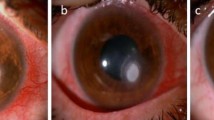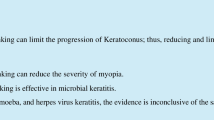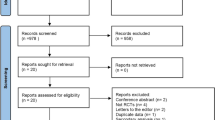Abstract
Purpose
To evaluate the efficacy of corneal cross-linking (CXL) as adjuvant therapy for the treatment of fungal ulcerative keratitis.
Methods
Forty-one patients with fungal ulcerative keratitis were recruited and assigned into two randomized controlled groups. These groups were treated with CXL combined with antifungal medications (CXL-M) or antifungal medications alone (M). The ulcers were assessed by slit-lamp biomicroscopy, slit-lamp images, in vivo confocal microscopy (IVCM), and anterior segment optical coherence tomography (AS-OCT). The patients were followed up before surgery/first visit (FV), 1 day after surgery, 1 and 2 weeks, and 1, 2, 3, 4, 5, and 6 months after surgery/FV.
Results
In the cured patients, the area of corneal ulcers, the duration of ulcer healing, the time to non-observed fungal hyphae by IVCM, the number of antifungal medications, the frequency of administered medications, and the maximum ulcer depth decreased significantly after CXL (all P < 0.05) compared with the M group. There were no significant differences in either corneal thickness or epithelial thickness of ulcers after healing between 5 and 6 months after surgery in the CXL-M group, while these were increased significantly at 6 months compared with 5 months after FV in the M group (both P < 0.05).
Conclusions
In our study, CXL accelerated healing of the fungal ulcers, shortened the treatment duration, and minimized the need for medications and surgery. It appears that CXL is an effective procedure and adjuvant therapy for managing fungal keratitis.




Similar content being viewed by others
References
Kernt M, Kampik A (2009) Intracameral voriconazole: in vitro safety for human ocular cells. Toxicology 258:84–93. https://doi.org/10.1016/j.tox.2009.01.008
Wu J, Zhang WS, Zhao J, Zhou HY (2016) Review of clinical and basic approaches of fungal keratitis. Int J Ophthalmol 9:1676–1683. https://doi.org/10.18240/ijo.2016.11.23
Prajna NV, Srinivasan M, Lalitha P, Krishnan T, Rajaraman R, Ravindran M, Mascarenhas J, Oldenburg CE, Ray KJ, McLeod SD, Acharya NR, Lietman TM (2013) Differences in clinical outcomes in keratitis due to fungus and bacteria. JAMA Ophthalmol 131:1088–1089. https://doi.org/10.1001/jamaophthalmol.2013.1612
Fini ME, Cook JR, Mohan R (1998) Proteolytic mechanisms in corneal ulceration and repair. Arch Dermatol Res 290 Suppl:S12–S23
Anwar HM, El-Danasoury AM, Hashem AN (2011) Corneal collagen crosslinking in the treatment of infectious keratitis. Clin Ophthalmol 5:1277–1280. https://doi.org/10.2147/OPTH.S24532
Martins SA, Combs JC, Noguera G, Camacho W, Wittmann P, Walther R, Cano M, Dick J, Behrens A (2008) Antimicrobial efficacy of riboflavin/UVA combination (365 nm) in vitro for bacterial and fungal isolates: a potential new treatment for infectious keratitis. Invest Ophthalmol Vis Sci 49:3402–3408. https://doi.org/10.1167/iovs.07-1592
Kimakura M, Usui T, Yokoo S, Nakagawa S, Yamagami S, Amano S (2014) Toxicity of topical antifungal agents to stratified human cultivated corneal epithelial sheets. J Ocul Pharmacol Ther 30:810–814. https://doi.org/10.1089/jop.2014.0044
Baier J, Maisch T, Maier M, Engel E, Landthaler M, Baumler W (2006) Singlet oxygen generation by UVA light exposure of endogenous photosensitizers. Biophys J 91:1452–1459. https://doi.org/10.1529/biophysj.106.082388
Garg P, Das S, Roy A (2017) Collagen cross-linking for microbial keratitis. Middle East Afr J Ophthalmol 24:18–23. https://doi.org/10.4103/meajo.MEAJO_305_16
Kymionis GD, Mikropoulos DG, Portaliou DM, Voudouragkaki IC, Kozobolis VP, Konstas AG (2013) An overview of corneal collagen cross-linking (CXL). Adv Ther 30:858–869. https://doi.org/10.1007/s12325-013-0065-9
Alhayek A, Lu PR (2015) Corneal collagen crosslinking in keratoconus and other eye disease. Int J Ophthalmol 8:407–418. https://doi.org/10.3980/j.issn.2222-3959.2015.02.35
O'Brart DP, Patel P, Lascaratos G, Wagh VK, Tam C, Lee J, O'Brart NA (2015) Corneal cross-linking to halt the progression of keratoconus and corneal ectasia: seven-year follow-up. Am J Ophthalmol 160:1154–1163. https://doi.org/10.1016/j.ajo.2015.08.023
Li G, Fan ZJ, Peng XJ (2012) Corneal collagen crosslinking for corneal ectasia of post-LASIK: one-year results. Int J Ophthalmol 5:190–195. https://doi.org/10.3980/j.issn.2222-3959.2012.02.15
Sharma N, Roy S, Maharana PK, Sehra SV, Sinha R, Tandon R, Titiyal JS, Vajpayee RB (2014) Outcomes of corneal collagen crosslinking in pseudophakic bullous keratopathy. Cornea 33:243–246. https://doi.org/10.1097/ICO.0000000000000004
Alshehri JM, Caballero-Lima D, Hillarby MC, Shawcross SG, Brahma A, Carley F, Read ND, Radhakrishnan H (2016) Evaluation of corneal cross-linking for treatment of fungal keratitis: using confocal laser scanning microscopy on an ex vivo human corneal model. Invest Ophthalmol Vis Sci 57:6367–6373. https://doi.org/10.1167/iovs.16-20110
Goodrich RP (2000) The use of riboflavin for the inactivation of pathogens in blood products. Vox Sang 78(Suppl 2):211–215
Iseli HP, Thiel MA, Hafezi F, Kampmeier J, Seiler T (2008) Ultraviolet A/riboflavin corneal cross-linking for infectious keratitis associated with corneal melts. Cornea 27:590–594. https://doi.org/10.1097/ICO.0b013e318169d698
Igal V, Pikkel Igal YS, Pikkel YY (2017) Corneal cross-linking as a treatment for fungal keratitis associated with corneal melting. Case Rep Ophthalmol 8:148–151. https://doi.org/10.1159/000456537
Shetty R, Nagaraja H, Jayadev C, Shivanna Y, Kugar T (2014) Collagen crosslinking in the management of advanced non-resolving microbial keratitis. Br J Ophthalmol 98:1033–1035. https://doi.org/10.1136/bjophthalmol-2014-304944
Li Z, Jhanji V, Tao X, Yu H, Chen W, Mu G (2013) Riboflavin/ultravoilet light-mediated crosslinking for fungal keratitis. Br J Ophthalmol 97:669–671. https://doi.org/10.1136/bjophthalmol-2012-302518
Mohan M, Panda A, Gupta SK (1989) Management of human keratomycosis with miconazole. Aust N Z J Ophthalmol 17:295–297
Shi W, Li S, Liu M, Jin H, Xie L (2008) Antifungal chemotherapy for fungal keratitis guided by in vivo confocal microscopy. Graefes Arch Clin Exp Ophthalmol 246:581–586. https://doi.org/10.1007/s00417-007-0719-x
Das S, Samant M, Garg P, Vaddavalli PK, Vemuganti GK (2009) Role of confocal microscopy in deep fungal keratitis. Cornea 28:11–13. https://doi.org/10.1097/ICO.0b013e318181cff7
Campoy S, Adrio JL (2017) Antifungals. Biochem Pharmacol 133:86–96. https://doi.org/10.1016/j.bcp.2016.11.019
Wang JY, Wang DQ, Qi XL, Cheng J, Xie LX (2018) Modified ulcer debridement in the treatment of the superficial fungal infection of the cornea. Int J Ophthalmol 11:223–229. https://doi.org/10.18240/ijo.2018.02.07
Xie L, Zhai H, Shi W (2007) Penetrating keratoplasty for corneal perforations in fungal keratitis. Cornea 26:158–162. https://doi.org/10.1097/01.ico.0000248381.24519.0d
Price MO, Tenkman LR, Schrier A, Fairchild KM, Trokel SL, Price FW, Jr. (2012) Photoactivated riboflavin treatment of infectious keratitis using collagen cross-linking technology. J Refract Surg 28: 706–713 DOI https://doi.org/10.3928/1081597X-20120921-06
Ozdemir HB, Kalkanci A, Bilgihan K, Gocun PU, Ogut B, Karakurt F, Erdogan M (2018) Comparison of corneal collagen cross-linking (PACK-CXL) and voriconazole treatments in experimental fungal keratitis. Acta Ophthalmol. https://doi.org/10.1111/aos.13829
Kimura K, Orita T, Nomi N, Fujitsu Y, Nishida T, Sonoda KH (2012) Identification of common secreted factors in human corneal fibroblasts exposed to LPS, poly(I:C), or zymosan. Exp Eye Res 96:157–162. https://doi.org/10.1016/j.exer.2011.10.015
Vajpayee RB, Shafi SN, Maharana PK, Sharma N, Jhanji V (2015) Evaluation of corneal collagen cross-linking as an additional therapy in mycotic keratitis. Clin Exp Ophthalmol 43:103–107. https://doi.org/10.1111/ceo.12399
Papaioannou L, Miligkos M, Papathanassiou M (2016) Corneal collagen cross-linking for infectious keratitis: a systematic review and meta-analysis. Cornea 35:62–71. https://doi.org/10.1097/ICO.0000000000000644
Spoerl E, Wollensak G, Seiler T (2004) Increased resistance of crosslinked cornea against enzymatic digestion. Curr Eye Res 29:35–40. https://doi.org/10.1080/02713680490513182
Hovakimyan M, Guthoff RF, Stachs O (2012) Collagen cross-linking: current status and future directions. J Ophthalmol 2012:406850. https://doi.org/10.1155/2012/406850
Wang F (2008) UVA/riboflavin-induced apoptosis in mouse cornea. Ophthalmologica 222:369–372. https://doi.org/10.1159/000151247
Pouget JP, Douki T, Richard MJ, Cadet J (2000) DNA damage induced in cells by gamma and UVA radiation as measured by HPLC/GC-MS and HPLC-EC and Comet assay. Chem Res Toxicol 13:541–549
Hiraku Y, Ito K, Hirakawa K, Kawanishi S (2007) Photosensitized DNA damage and its protection via a novel mechanism. Photochem Photobiol 83:205–212. https://doi.org/10.1562/2006-03-09-IR-840
Wollensak G, Spoerl E, Reber F, Seiler T (2004) Keratocyte cytotoxicity of riboflavin/UVA-treatment in vitro. Eye (Lond) 18:718–722. https://doi.org/10.1038/sj.eye.6700751
Wollensak G, Sporl E, Reber F, Pillunat L, Funk R (2003) Corneal endothelial cytotoxicity of riboflavin/UVA treatment in vitro. Ophthalmic Res 35:324–328 DOI 74071
Spoerl E, Mrochen M, Sliney D, Trokel S, Seiler T (2007) Safety of UVA-riboflavin cross-linking of the cornea. Cornea 26:385–389. https://doi.org/10.1097/ICO.0b013e3180334f78
Mazzotta C, Balestrazzi A, Traversi C, Baiocchi S, Caporossi T, Tommasi C, Caporossi A (2007) Treatment of progressive keratoconus by riboflavin-UVA-induced cross-linking of corneal collagen: ultrastructural analysis by Heidelberg Retinal Tomograph II in vivo confocal microscopy in humans. Cornea 26:390–397. https://doi.org/10.1097/ICO.0b013e318030df5a
Hafezi F (2011) Limitation of collagen cross-linking with hypoosmolar riboflavin solution: failure in an extremely thin cornea. Cornea 30:917–919. https://doi.org/10.1097/ICO.0b013e31820143d1
Raiskup F, Spoerl E (2013) Corneal crosslinking with riboflavin and ultraviolet A. Part II. Clinical indications and results. Ocul Surf 11:93–108. https://doi.org/10.1016/j.jtos.2013.01.003
Rahman MR, Johnson GJ, Husain R, Howlader SA, Minassian DC (1998) Randomised trial of 0.2% chlorhexidine gluconate and 2.5% natamycin for fungal keratitis in Bangladesh. Br J Ophthalmol 82:919–925
Foster CS, Lass JH, Moran-Wallace K, Giovanoni R (1981) Ocular toxicity of topical antifungal agents. Arch Ophthalmol 99:1081–1084
Allan BD, Dart JK (1995) Strategies for the management of microbial keratitis. Br J Ophthalmol 79:777–786
Zloty P, Villavicencio O, Belin MW (2013) Aggressive debridement improves outcome of fungal keratitis. Asia Pac J Ophthalmol (Phila) 2:217–220. https://doi.org/10.1097/APO.0b013e3182993f4b
McGrath LA, Lee GA (2014) Techniques, indications and complications of corneal debridement. Surv Ophthalmol 59:47–63. https://doi.org/10.1016/j.survophthal.2013.03.004
Chan E, Snibson GR, Sullivan L (2014) Treatment of infectious keratitis with riboflavin and ultraviolet-A irradiation. J Cataract Refract Surg 40:1919–1925. https://doi.org/10.1016/j.jcrs.2014.09.001
Funding
This work was supported by grants from the National Natural Science Foundation of China (No. 81300759).
Author information
Authors and Affiliations
Corresponding author
Ethics declarations
Conflict of interest
The authors declare that they have no conflict of interest.
Ethical approval
All procedures performed in studies involving human participants were in accordance with the ethical standards of the institutional and/or national research committee and with the 1964 Helsinki declaration and its later amendments or comparable ethical standards.
Informed consent
Informed consent was obtained from all individual participants included in the study.
Additional information
Publisher’s note
Springer Nature remains neutral with regard to jurisdictional claims in published maps and institutional affiliations.
Anji Wei and Kaidi Wang are the co-first authors.
Rights and permissions
About this article
Cite this article
Wei, A., Wang, K., Wang, Y. et al. Evaluation of corneal cross-linking as adjuvant therapy for the management of fungal keratitis. Graefes Arch Clin Exp Ophthalmol 257, 1443–1452 (2019). https://doi.org/10.1007/s00417-019-04314-1
Received:
Revised:
Accepted:
Published:
Issue Date:
DOI: https://doi.org/10.1007/s00417-019-04314-1




